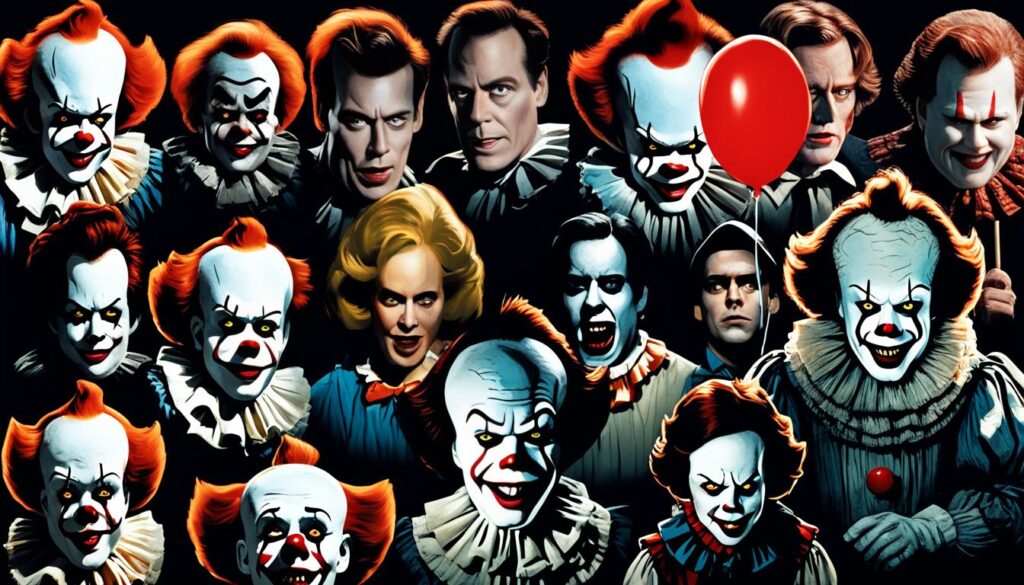For all the fans of horror literature out there, we bring you an opportunity to experience the fear and horror like never before. Get ready to immerse yourself in the eerie world of Stephen King’s IT and download the PDF version of this iconic novel right away!
With his masterful storytelling, Stephen King has captivated readers all over the world. And IT is undoubtedly one of his most famous works. Set in the town of Derry, Maine, IT tells the chilling story of a group of childhood friends who must confront an ancient evil lurking beneath their hometown.
Are you ready to join the Losers’ Club and face your deepest fears? Click on the link below to download Stephen King’s IT book PDF now!
Key Takeaways
- Stephen King’s IT is an iconic horror novel that has captivated readers all over the world.
- You can download the PDF version of the IT book by Stephen King by clicking on the link above.
- IT tells the story of a group of childhood friends who must confront an ancient evil lurking beneath their hometown.
- The novel is filled with complex characters and explores themes of fear, friendship, and trauma.
- IT has had a lasting impact on the horror genre and has been adapted into several successful movies and TV series.
Introduction to Stephen King’s IT
Stephen King’s IT is a horror masterpiece that has earned a place among the most celebrated works of fiction in contemporary literature. The story takes place in Derry, Maine, a fictional town that serves as a backdrop for the unfolding terror. The novel introduces readers to Pennywise, a clown that embodies evil itself.
The setting of Derry, Maine, is essential to the story. It serves as a character itself, with its own dark history and disturbing secrets. King expertly creates a sense of unease and foreboding that permeates the narrative, causing readers to feel a sense of dread and anticipation as they turn each page.
Pennywise is a haunting and deeply malevolent character that terrorizes the inhabitants of Derry, Maine. The clown is the embodiment of evil, picking off the vulnerable and innocent with ease. King’s ability to create such an iconic villain is just one of the many reasons why Stephen King’s IT remains as relevant and captivating as ever.
Plot Summary of Stephen King’s IT
Stephen King’s IT is a masterful horror novel that takes place in the town of Derry, Maine. The story follows the lives of a group of childhood friends, known as the Losers’ Club, who reunite as adults to confront a terrifying evil that has haunted their town and their lives for decades.
The novel takes place over two timelines, one in which the Losers’ Club is fighting the evil as children, and the other when they return to Derry as adults to face it once and for all. Throughout both timelines, the Losers’ Club face their deepest fears and insecurities as they attempt to confront the ancient evil that has emerged once again to claim the town.
Their encounters include facing the malevolent clown, Pennywise, who embodies evil, and who has been the source of fear and terror for generations of children in Derry. Pennywise has the ability to shapeshift and prey on the individual fears of its victims, making it an even more daunting adversary to the Losers’ Club.
The Losers’ Club members have their own unique battles to overcome as well, including dealing with abusive parents, bullying, and personal traumas. Despite their struggles, they band together to fight Pennywise, forming an unbreakable bond of friendship that drives them forward.
Main Characters in Stephen King’s IT
Stephen King’s IT introduces readers to a cast of memorable characters whose lives are intertwined with the menacing force that haunts their hometown of Derry, Maine. As the Losers’ Club bands together to face their worst fears, each of these characters must grapple with personal demons and a malevolent entity that is far beyond their understanding.
Bill Denbrough is the de facto leader of the Losers’ Club, driven by a determination to uncover the truth about the disappearances of his younger brother and other children in the town. Beverly Marsh struggles with trauma and abuse at home, while Ben Hanscom faces bullying and loneliness.
Eddie Kaspbrak is plagued by hypochondria, Stanley Uris grapples with obsessive-compulsive disorder, and Richie Tozier uses humor to mask his insecurities. Finally, Mike Hanlon carries with him the weight of a dark family history and a legacy that ties him to Derry’s bloody past.
Through their individual struggles, these main characters in Stephen King’s IT come together to form a bond that is both fragile and unbreakable. Their collective journey, spanning multiple timelines and dimensions, forms the backbone of King’s horror masterpiece.
Themes and Symbolism in Stephen King’s IT
The themes in Stephen King’s IT explore the complexity of human relationships and the power of belief in overcoming fear. Fear is the driving force behind the story, affecting each character in different ways. The Losers’ Club bonds over their shared fear of Pennywise, the terrifying clown that haunts Derry, Maine. Their friendship becomes a powerful tool in their fight against evil and serves as an example of the strength that comes from genuine human connections.
Symbolism plays a crucial role in Stephen King’s IT, adding depth and complexity to the story. The most prominent symbol is the color red, which is used to represent the blood of both innocent victims and guilty perpetrators. The color is also associated with passion and anger, two emotions that are closely tied to the story’s themes. Other symbols include the turtle and the ritual of Chüd, which represent ancient knowledge and the power of myth, adding layers of depth to the story.
Through its themes and symbolism, Stephen King’s IT continues to captivate readers and audiences alike, cementing its place as one of the most influential horror novels of all time.
Stephen King’s Writing Style in IT
Stephen King is widely regarded as a master of horror, and his unique writing style in IT contributes greatly to the novel’s success. King’s ability to create an atmosphere of terror and suspense is unparalleled, with vivid descriptions of the sinister town of Derry, Maine, and its menacing clown, Pennywise. The author’s use of long, descriptive sentences and powerful imagery immerses readers in the story and heightens the sense of fear and unease.
Beyond the suspense, King is known for his skill in developing complex characters that resonate with readers long after the book has ended. In IT, the members of the Losers’ Club are fully fleshed-out characters with detailed backstories and deep emotions. King’s ability to delve into the psychological complexities of his characters is a hallmark of his writing and contributes greatly to the novel’s impact.
“We lie best when we lie to ourselves.”
King’s use of themes such as fear, trauma, and the power of belief adds depth and complexity to the story. The symbolism woven throughout the novel also enhances its meaning, making IT a multi-layered masterpiece of horror literature.
Overall, Stephen King’s writing style in IT is a key factor in the novel’s enduring popularity. It is a must-read for horror fans and anyone interested in experiencing a masterful work of fiction.
IT’s Impact on the Horror Genre
Stephen King’s IT has left an indelible mark on the horror genre, influencing subsequent works of horror literature and film. The novel’s impact can be seen in the widespread popularity of horror stories featuring supernatural entities like Pennywise, the demonic clown.
IT redefined the horror genre by expanding its boundaries and delving into new depths of terror. The novel’s complex, interwoven plot and richly developed characters set a new standard for horror storytelling. Furthermore, King’s masterful use of suspenseful pacing and vivid descriptive language keeps readers on the edge of their seats.
For many readers, IT was a gateway into the horror genre, encouraging them to explore other works of horror fiction. The novel’s success paved the way for other horror authors and created a renewed interest in the genre among readers and critics alike.
Adaptations of IT, including the 2017 film and the TV miniseries, have continued to showcase the novel’s lasting impact on the horror genre. These adaptations have introduced IT to new audiences, solidifying its place as a true classic of horror literature.
“By crafting a unique and unforgettable horror story that goes beyond the limitations of the horror genre, Stephen King solidified his place among the greatest horror writers of all time.”
Critical Reception of Stephen King’s IT
Stephen King’s IT has garnered both critical praise and criticism since its initial publication in 1986. The novel has been widely acclaimed for its masterful storytelling, vivid characters, and powerful imagery.
“IT is a sprawling, ambitious novel that takes risks, subverts expectations, and ultimately delivers a haunting and unforgettable reading experience. King’s ability to capture the unsettling nature of childhood fears and traumas is nothing short of remarkable.”
However, some critics have taken issue with the length and complex narrative structure of the novel. Some argue that the book’s interweaving timelines and frequent shifts in perspective can be confusing for readers and detract from the overall impact of the story.
“While IT is undoubtedly a classic work of horror fiction, it does suffer from a certain amount of bloat and repetition. King’s insistence on including every detail and subplot can make the book feel meandering and unfocused at times.”
Despite these criticisms, Stephen King’s IT remains one of the most beloved and influential works of modern horror literature. Its impact on the genre cannot be overstated, and it continues to captivate new generations of readers to this day.
Adaptations of IT
Stephen King’s IT has been adapted into several films and television series. The first adaptation was a two-part television miniseries released in 1990. Starring Tim Curry as Pennywise, the series followed the book’s plot and became a cult classic. However, the series was criticized for its poor special effects and limited runtime to cover the novel’s vast content.
The sequel follows the 2017 critically acclaimed film adaptation directed by Andy Muschietti. Starring Bill Skarsgård as Pennywise, the movie was praised for its performances, effects, and faithfulness to the source material, while still making some changes, particularly in the timeline of the events and focus on horror over the adult storyline.
There was a follow-up film, IT: Chapter Two, released in 2019, and a prequel series, Castle Rock, which explored themes and locations from the Stephen King universe, including elements from IT.
Despite some deviations and mixed reviews, most adaptations have been successful in capturing the essence of the novel and bringing its iconic characters and scenes to life.

Conclusion and Recommendation of IT
Stephen King’s IT is a horror masterpiece that continues to captivate readers and audiences alike. Its enduring popularity is a testament to King’s ability to create a chilling atmosphere and develop richly complex characters that resonate with readers long after they turn the last page.
For those who are new to the novel, we highly recommend giving it a read. It is a must-read for fans of horror and those looking to explore the deeper themes of fear, friendship, and trauma. While IT may be a lengthy read, its intricate narrative structure and masterful storytelling make it well worth the investment of time.
Overall, Stephen King’s IT is an unforgettable journey into the heart of darkness. Whether you are a longtime fan or a curious newcomer, we recommend experiencing the terror and suspense that await you in Derry, Maine.



